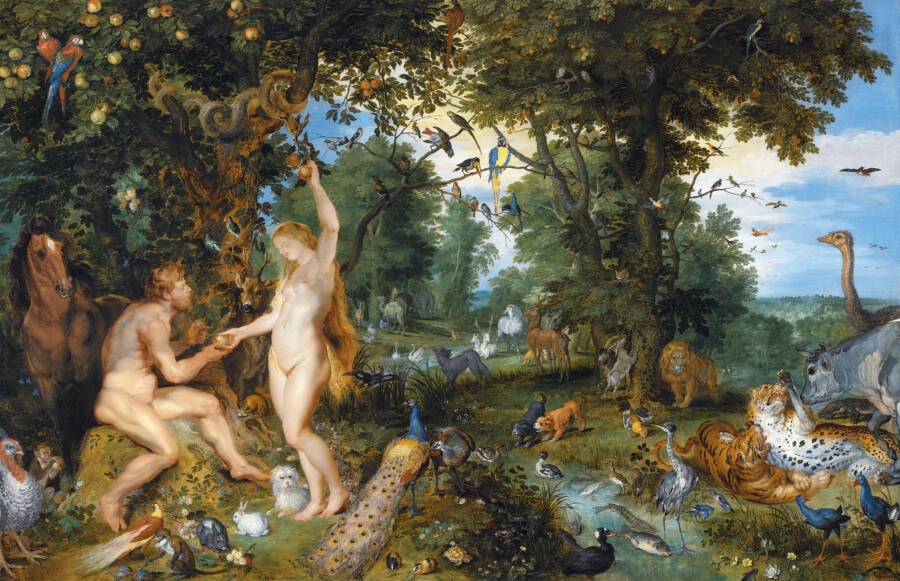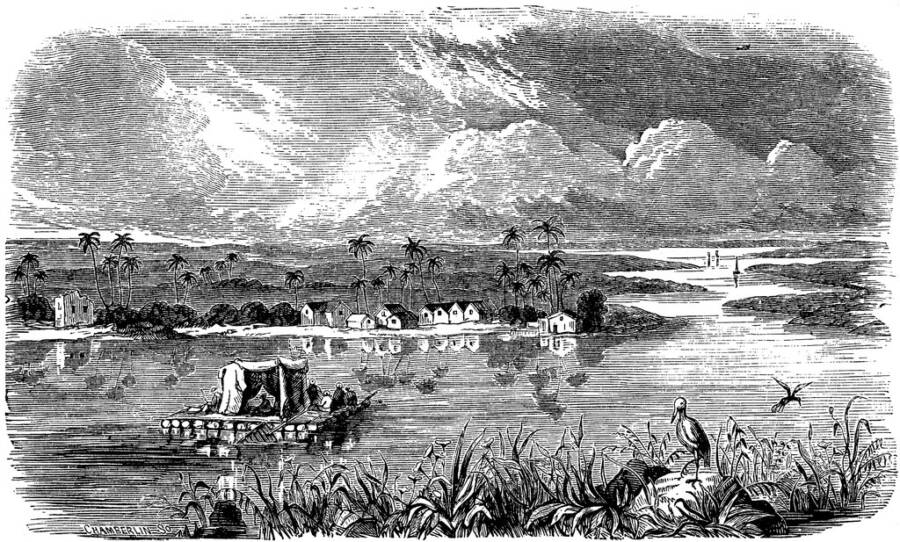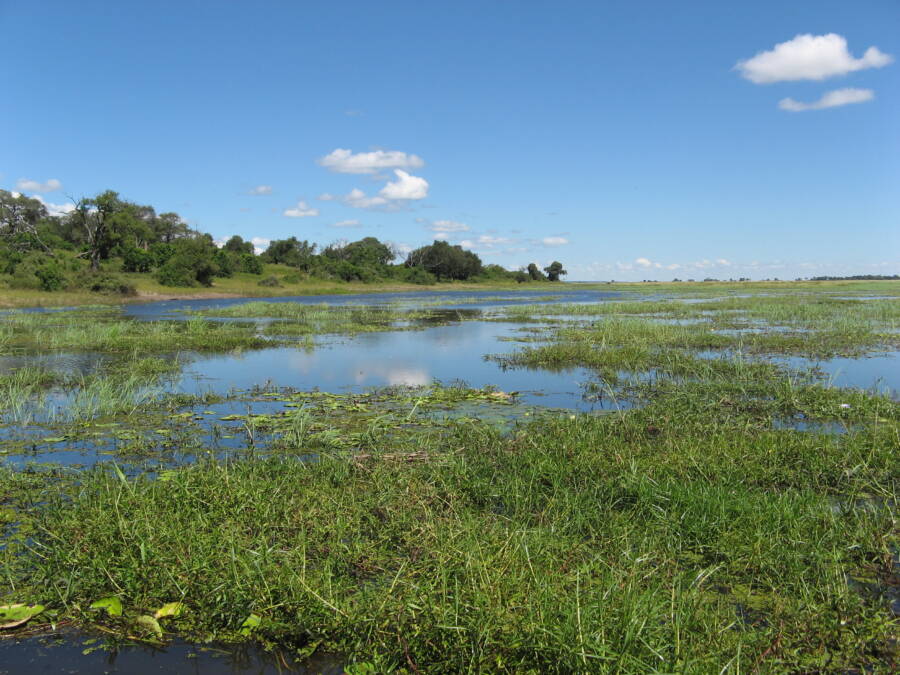Theorists over the centuries have said the Garden of Eden's location is in places like Mesopotamia, Ethiopia, Botswana — and even Missouri.

Public DomainThe Garden of Eden with the Fall of Man, circa 1615, by Peter Paul Rubens, Jan Brueghel the Elder.
According to Abrahamic religions, after God created the Earth, he made man in the form of Adam and placed him in the Garden of Eden. And although humanity was later expelled from this paradise, some believe it was a real place — or, at the very least, based on one. So, where was the Garden of Eden?
The Garden of Eden as described in scripture was like a heaven on Earth — so it stands to reason that people would be eager to find it. In the Book of Genesis, it’s said to sit at the meeting point of four rivers, and over the centuries, many have speculated as to where this might’ve been, offering up theories about the Garden of Eden’s location including the Persian Gulf, Ethiopia, and even Jackson, Missouri.
But were any of them right? Here’s the real history of the Garden of Eden and where it may have been located.
Where Was The Garden Of Eden? What The Book Of Genesis Says
As the story of the Garden of Eden goes, when God created man, he placed him in a verdant paradise.
Central to the garden was a tree, the Tree of the Knowledge of Good and Evil, the fruit of which God forbids man to eat. In the end, of course, God throws humanity out of the garden because Adam and Eve willfully ate the fruit and gained knowledge of good and evil.
The speculation over the real-world location of the Garden of Eden comes from a passage in the Bible’s book of Genesis:
And a river went out of Eden to water the garden; and from thence it was parted, and became four heads. The name of the first is Pishon; that is it which compasseth the whole land of Havilah, where there is gold; and the gold of that land is good; there is bdellium and the onyx stone. And the name of the second river is Gihon; the same is it that compasseth the whole land of Cush. And the name of the third river is Tigris; that is it which goeth toward the east of Asshur. And the fourth river is the Euphrates.
Here, the Bible outlines clear criteria for identifying the Garden of Eden. So what sites fit this description?
Was The Garden Of Eden In The Fertile Crescent?
Significantly, the Tigris and the Euphrates are real rivers in the historic Fertile Crescent. Based on this, the obvious answer would seem to be that the Garden of Eden lies somewhere in Mesopotamia. In addition to being home to the Tigris and Euphrates rivers, the region was also the part of the world in which many of the events depicted in the Bible occurred.

Wikimedia CommonsAn illustration of the confluence of the Euphrates and Tigris rivers.
Still, there’s been much debate over the precise location of the Garden of Eden within the region.
The area with the strongest argument may be that of the Persian Gulf, somewhere around southern Iraq, Kuwait, and Iran, where the Tigris and Euphrates rivers meet the sea.
Some even argue the garden was located in Armenia, as the Armenian highlands dip into Mesopotamia from the north.
But some argue the origins of the Garden of Eden are likely to be found in the scientific birthplace of humanity itself: Africa.
The Scientific Birthplace Of Humanity May Have Also Been The Biblical One
While the generally accepted modern theory that humans first developed in Africa hundreds of thousands of years ago is based in scientific evidence, the argument for an African Garden of Eden begins with the translation of the word “Cush” from the pivotal Genesis passage describing the garden.
Some interpret or translate the name Cush as “Ethiopia” — placing the Garden of Eden south of Mesopotamia.
It certainly would fit the story, as Ethiopia is not far from the location of many of the other events in Abrahamic scripture, which take place just across the Red Sea.
But evidence from the scientific community pushes the Garden of Eden’s location even farther southward. In 2019, it was widely reported that the Garden of Eden, symbolic or not, would have been in Botswana hundreds of thousands of years ago, according to a recently released study published in Nature.
The study compared the mitochondrial DNA of modern humans in southern Africa to analysis of modern linguistics, historic climate patterns, and the geographic distributions of local populations to argue that the birthplace of mankind was likely south of the Zambezi River in northern Botswana.
There, humanity would have thrived for tens of thousands of years before eventually being forced to migrate due to climate issues, mirroring the biblical tale of Genesis on a grand scale.

Wikimedia CommonsThe lush Zambezi River in Botswana.
However, these various locations in Africa are far from the only alternative theories for the location of the Garden of Eden.
Surprising Theories About The Garden Of Eden’s Location
Several groups claim the Garden of Eden actually existed far from broadly accepted theorized locations like Mesopotamia.
Most famous of these may be the Church of Jesus Christ of Latter-day Saints. According to FOX 2, the church, formed in New York in 1830, adopted the position that the Garden of Eden was located in the vicinity of Independence, Missouri and that after their banishment from the garden, Adam and Eve moved to Daviess County, Missouri, around 70 miles away.
The church’s members would attempt to settle in the area in the 1830s. Tensions with other settlers eventually pushed them out of the state, but not before Joseph Smith declared the land to be the future gathering place of the righteous at the end of the world.
And despite little geographical or textual evidence supporting the theory, the LDS church has nonetheless accumulated vast swathes of land in the area — around 3,000 acres.
The Latter-day Saints aren’t the only group to make a significant break from predominant theories around the Garden of Eden’s location.
In the early 20th century, the Panacea Museum reports that members of the Panacea Society of Bedford, England believed the Garden of Eden was located precisely there, and that the city had been built on top of it.
Just a few decades later, in America, Preacher Elvy E. Callaway argued that the Garden of Eden could be found in Florida along the Apalachicola River, briefly turning the area into a tourist attraction, according to Florida Back Roads Travel.
Even Christopher Columbus is reported to have believed he discovered the Garden of Eden on his third trip to the Americas when he reached the Venezuelan coast.
Was The Garden Of Eden Even Real — And Will We Ever Know?

Public Domain16th-century French theologian John Calvin dismissed the idea that the Garden of Eden was in Mesopotamia.
Some, however, believe there’s no actual location of the Garden of Eden, either because it doesn’t exist or because the world has changed so drastically since the story of Genesis that the offered description in scripture amounts to little in terms of modern-day geography.
The famous 16th-century French theologian John Calvin pondered the question of the lost Garden of Eden, arguing that the Euphrates and Tigris rivers were insufficient evidence for the garden’s location.
Even though they share the names of the rivers mentioned in Genesis, he argued, they don’t meet with two other rivers in the way the biblical ones do, meaning that the four rivers as described in the Bible likely don’t exist in the region.
Calvin floated the idea that it was unlikely that the garden’s Biblical description has any bearing on where it would be today — due a cataclysmic event that, according to biblical belief, would have changed the very surface of the Earth: the Great Flood.
In the story of the Great Flood, the world was covered in water for 40 days and nights, with tempests raging as the water churned violently across the globe. According to Calvin’s logic, such an event would have reshaped the Earth, wiping away the original Garden of Eden’s identifying waterways.
Whether it was real, mythical, or washed away by a global flood, the true location of the Garden of Eden has remained elusive.
Could it have been in Mesopotamia, where many of the scriptures themselves were written? Could Africa be the origin of humankind and home to the garden as well? Is it even possible to find, or were its identifying features washed away in a flood of biblical proportions?
Then again, it may have just been in Missouri the whole time.
After reading about the real location of the Garden of Eden, discover the search for other mythic locales like Alexander the Great’s tomb, or the lost continent of Lemuria.





